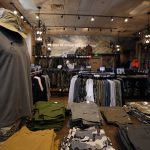Was the Salomon acquisition primarily an apparel or equipment buy?
It was primarily an equipment acquisition for us. I dont think this will shift our major strategic outlook from that perspective because we will still be very focused on equipment; that is our core. We feel that we need to have one strong platform and build out from there. That platform is equipment. However, we never of course officially talked about apparel because we wanted to achieve our goals in equipment first.
The bigger we get in equipment the harder it is to grow in that category. We have, in our internal projections, said for quite a few years that technical apparel and technical footwear could be interesting because the line between equipment and technical apparel is not very clear. We see more and more foot wear and ski wear or technical wear generally becoming more technical. It is still in an early stage, but we expect to see apparel to become, to some extent, intelligent. And I know that there are many projects going on in that end.
So, we have looked at apparel as a way to diversify ourselves and with the Salomon acquisition, this was a very natural way to accomplish this. I would say it has many good brands and good companies in that group.
Now that the acquisition has been announced, are there any future categories that you would like to be in?
The bike business has been one of the categories. I have been very clear that the component category is where our interest lies. The bike business, the profitability of the business of actually assembling completed bikes, has not been very good. The value has been in components both to bike manufacturers and to the consumers who buy the components. We have a lot of opportunities there in the future. As we get a little bit down the road here and get a clearer strategic outlook and have an opportunity to talk some more with the people at Mavic, I think that category has many possibilities. Right now they are a very small player in a very big market.
So, you see this as an entry into broader bicycle component business?
It could be… It could be. I am not excluding that at all at the moment. If we look at electronics for example, in that area we have already the sort of components that we can expand upon in that area. I think there is also a lot of consolidation that could take place in the bike industry some of it has already started. Lets put it this way, that is an opportunity.
But we arent going to see Mavic bicycles in the near future?
Momentarily, I would say hardly, but I have to talk with the Mavic people themselves. I dont think so at this point. I dont envision that myself.
We have spoken with some other footwear CEOs who consider themselves more of an equipment company than a footwear company. Do you see these as similar in their approach?
I am not a footwear specialist, we only have a small racquet sports footwear department, but we have also considered out sports footwear as more equipment than traditional footwear.
The footwear market divides into two broad sectors the fashion footwear market like lets say the great success of Puma in the past five years. This is kind of relying on the sporting image, and then the real technical footwear which is places a lot of emphasis on the R&D behind it and creates a real performance product. That is where I think we can have something to say and I think something can be done whether it is in the outdoor, hiking, climbing market or any other market where we can leverage the technology.
Salomon and adidas seem to have a lot of shared technology and RD&D efforts. Is it going to be difficult to separate the two brands?
What I understand is that there is not that much. There is some but not that much and that is the reason we have made this service agreement between us and the adidas-Salomon group. It is designed to make a smooth divestment or dis-integration, of these two companies. I have the understanding that not a huge amount of technology has been shared, that Salomon has been standing alone apart from source organizations, etc. Of course this is a delicate matter. We have to make sure that we dont loose anything and they dont loose anything. We have to be very careful here.
So, the three-year partnership includes any shared RD&D efforts? Its not just sourcing?
Lets put it this way, it is a very broad sourcing agreement that covers a lot of different fields. Primarily it covers any fields that have any integration with each other, including subsidiary operations, information systems, etc
Arcteryx and some of the other brands were clearly benefiting from the sourcing structure at adidas-Salomon; do you think they will continue to have these sourcing benefits? Are you looking at new sourcing efforts?
It is evident that the whole sourcing structure is a big issue, particularly the whole Salomon shoe and apparel have been sourced through the adidas-Salomon sourcing organization, and that is something we will have to look at very carefully. On the Amer Sports side we have a sourcing organization based in our headquarters in Taiwan with over 100 people on staff. This is also something we have to be very careful about.
We have to strengthen our worldwide sourcing organization, particularly the part which is in Asia, and I think be a very natural flow for the Salomon organization. We have two or three years in which to make it work in the best possible way. Whether all of the entities go through there I dont think everything goes through there today that is one of the critical elements to be fixed in the proper way.
Are most of your energies moving forward going to be focused on the Integration of Salomon or will you remain active with acquisitions?
That is a good question. There are two stretches we have to work on. We have to be serious about what we are doing. This is a big acquisition for us. We are used to being quite lean and mean, so it will require a lot of dual work from our people and I have to be careful that I do not push too many of our people in different directions at the same time. Having said that, though we work in a very decentralized manner, so for example this work will not concern the Wilson guys in the U.S. or Precor. This will be more of a European integration overall. Therefore I think that overall from a human resource standpoint we should have the means to get things done.
The other part of course is from the financial standpoint. This leverages out balance sheet maybe a little bit more than we would do normally, so I think I would like to se that more in balance before we do any major acquisitions.
Of course, I know there are things we could do to strengthen the balance sheet if necessary, but the primary focus is to integrate the company and then we will see how we go forward.
Now that you have your own apparel resources with Salomon, will you begin to use that to launch apparel lines for your existing brands, or will you continue with licensing your brands for apparel?
We havent really been serious with apparel in our organization. We have some licensing in some specific areas, as you pointed out correctly, with racquet sports, golf to some extent, and some other areas. We have just very recently signed from a team sports perspective signed a licensing agreement with Fruit of the Loom, so that – of course – will continue. Whether we continue and extend these licenses, we still have to decide. We need to discuss with Salomon, ArcTeryx and Bonfire what they want to do. Of course, it is natural to try to build on their platform and their knowledge and their brands as we move forward.
I believe you said that Amer initiated the talks with adidas, what made you think Salomon would be a good fit?
There is this wave of consolidation going on, and we firmly believe that we need to be number one or number two in the different categories to survive in the long term. There is consolidation going on in the trade there are some good examples going on in the United States and as well in Japan. There is also consolidation in the supply side. We have the number one single ski brand with Atomic.
We are not number one in the broader sense in Winter Sports equipment market, and we have seen a very strong consolidation from a product standpoint today skis and bindings go together, and I have to say we initiated that movement ourselves and were the leader in that category as we went from 40,000 pairs of ski bindings to 800,000 pairs over the course of a few years. At the same time there is a down side to the integration in the sense that if you are not strong in all of the Wintersports categories, there is the risk that someone will come along and play the game in a different way. We felt we need to take the initiative to consolidate the market and be in a position to hopefully pick up a possible partner. In this case we were lucky that Salomon was available and this allows us to have a very strong portfolio in the winter sports market.
The interesting thing, which is fantastic, is that our current winter sports business is strong in some markets, like the Germanic market and the cross country market where as we are weak in ski boot and cross country ski boots and Salomon vice versa is weak where we are strong.
They are weak in skis especially in technology but they are very strong in cross country skis and cross country norms. That is one aspect where we really can create a win-win situation out of this. Both parties are eager to go down this road.
Salomon is also geographically weak where we are strong in the sense that we dont see any markets where we will be so strong that we will have problems with the authorities. And therefore, it is a good situation from a geographic standpoint and from a product balance standpoint. Also with the new entries in the bicycle market and outdoor market, so we really see this as a good fit.
Do you see setting up a tiered brand strategy? How do you see positioning these brands with the SnowSports consumer?
The brands have not consolidated as fast as the companies are forced to consolidate. We are committed to this multi-brand strategy, much like the car market, or the consumer electronics market, stereos cameras etc
From a consumer standpoint it has crystallized and I call them tribes out there. It seems to be similar all around the world, but they keep paralleling the different markets. We have already embarked, two years ago, on a multi-brand strategy. For instance with Volant we have positioned it as the really high end luxury ski you dont really see that yet in the United States, they are still going through a transition, but in Europe Volant is truly a luxury brand.
I think Pierre DuMont (?ph) from Salomon put it best when he said, Salomon dominates the backside of the mountain and Atomic dominates the front side of the mountain of course there is always a little bit of overlap
Not one above the other I dont think one should be in a lower position that would be a mistake. We have to remember from a business perspective, we live off of our margins and that is very critical for us as we need high end on both sides. If we look at the market ten years ago there was a high-end, a middle, and a low-end where the high end was a racing ski and the middle was slightly stripped down and the low was a totally stripped down basic ski. Today that is not the case the market is much more complex than that with all of the new school, free ride, free style, race, the SUV of skis.
Do you see leveraging the ArcTeryx name and create more of a presence in hardgoods?
I havent had the chance to speak with the Arcteryx management yet. I really look forward to it. I have a lot of appreciation for what they have done with the brand with the very high end and the patents they have on their products. I have the understanding that their first priority is to expand into Europe and if can any way help them with that, then that would be our first priority. I will leave that for them to decide I will discuss with them what they want to do.
Is international expansion a priority for many of your brands? For instance we have seen the success with Wilson Golf and Wilson Team Sports.
Yes the international expansion of our brands is a focus for us and specifically we have had a major focus on team sports they are all the time breaking records and they are at their highest point ever in sales and profitability and it is all because of the guys in the US that have managed to create technology that really are break-through, specifically DiMarini bats in the U.S. but also in the Japanese market, which is extremely important market for baseball and I think we are the first foreign company to really move the needle. We have up-front investments in a professional baseball team in Japan, buying people out from out competitors and they are really moving this forward.
We also have big initiatives in Latin America with the Wilson brand, but I also have to say that team sports are also going up in Canada. So, we have the emphasis and we have this international network, and we have an American guy now in Europe that is working on the team sports there. So we have a big opportunity. Having said that even racquet sports is showing high sales. We have ultra-high profitability and sales numbers in the whole Wilson business, even though golf is not at its best level. We have also expanded the racquet sports, we have a big initiative in Asia on badminton in EU and Asia and Japan specifically in tennis balls in Japan we managed to crack a bit of the wall that the brands have built there.
So, all of the brands in our portfolio which are more local in nature are benefiting now from the infrastructure we have set up and we are opening new subsidiaries all of the time Russia is coming up very well, we opened up Switzerland a few years ago, and we have some smaller countries like Estonia, Holland etc.
Of course our very big efforts in Japan with now everything under one roof I would almost bet that outside of the United Stated Japan will be our biggest subsidiary within one year. So, you know, its moving very well
With your involvement in Japan, I am sure you are looking at the 800 pound gorilla to the South and west of you. Do you have any partners in China or initiatives for your brands?
We already are preparing the market by being involved in Chinese culture and activities through marketing. We have increased the number of Wilson shop-in-shops to increase the brands exposure. We had all of our executive board members, last November, on an extensive China trip with meetings with all of the officials of the China Olympic committee with talks for one full week in Beijing and Shanghai. We have our own operations in some areas, like fitness with Precor and we have Wilson people and we are looking very carefully at the ski market there which is developing quickly.
But, we are of the opinion that the infrastructure for hardgoods is not yet on any very important level. We are not going to be too rushed there it is not going to open up tomorrow. I think it is gradually going to open up and as the infrastructure develops, as places to practice your sport begin to develop and then it will grow gradually.
In the places where we have some visibility, the biggest opportunities in the short-term are tennis, the outdoor market, to some extent some team sports like basketball, and then mid term we see the winter sports coming up, but that is still quite regional and of course it goes without saying that badmitton is very important in China. So, I think we will take our time and continue to operate as we do today. We will fine tune our strategies, but within lets say the next 12 months, we dont foresee that we will open up any of our own operations at this stage.
But you do have a partner over there that can open up retail stores?
Yes, we have all of our categories represented at retail in China. We have a very good fitness business there, we have a good solid racquet sports business there, we have a winter sports business there that is starting to show good results, we even sell our Suunto wrist top computers there. So, we are present. We havent made any kind of major push there because we think it is maybe a little bit too early.
How is the fitness business shaping up today? What is on the horizon?
I think we have the right offering now in entertainment, strength product and in cardiovascular product. It actually has helped our cardiovascular sales to have the complete balance. So we will of course fine tune that. We have new interesting products coming up. We went even to a lower price point because we started out with $3,000 upwards now we are having offerings in the $2 to $3,000 range. We are still working on the international market.
We havent yet been able to supply the full offering to the international market because… we havent been able to take it to the levels where we need to. However that will happen very soon I would say 12-18 months. And then we can become even more competitive on the international market and come in as a third player with Life Fitness and Techno Gym.
Not only in Europe where we have expanded our presence into several countries we have opened up Spain and Switzerland and France very recently but also Japan has done very well with our organization but also the (emerging) markets whether its Russia or China which we already mentioned. So, I think while our biggest subsidiary could be Japan, our biggest division – excluding the Wintersports business where we will be going in with two brands will be the fitness industry, because it is growing very, very well and it is more like we just have to hang on to it now and let them execute their strategies. So it is very interesting right now and of course we keep a very close eye on this.
Electronics is gaining a foothold in sporting goods, in footwear and even in apparel to some extent. Do you see integrating new technology into the golf, into wintersports, or even racquet sports with what you have under the Suunto division?
Nothing really is visible yet at this stage. I have been very clear and open with this from a strategic standpoint.
Suunto has two major things to accomplish first they have to participate and really build the category of wrist top computers or sports instruments, which is really tough work to do because it is a completely new category that has to be created. We have the first generation now out there and the second generation will be coming in the next two years and it will be very interesting because it will be on a completely different level. The interesting thing we have done with Suunto is that we have built the technology platforms so that we can now do a lot of interesting things. So technology wise, we are quite, quite advanced, but product wise we still have a ways to go.
The second part of our ambition is to really try to put some intelligence into traditional mechanical equipment. We strongly believe my vision has been very clear on this. As mechanical products become more electronic then of course more with software so that they can be more customized so with software then electronics become even more important. It looks like we are the only equipment company in the world today that has mastered both mechanical and electronic engineering.
We have a lot of projects going on. Which of them will fly has yet to be seen. I can offer only this much if you take for example our new T6 heart rate monitor it is the first one in the world that measures heart rate through RF technology, which is radio frequency technology. All of the old ones, both our and other measured it through, with magnetic measurements. Now RF is good because you can put the same wavelength on different products. So, our pilot product in alpine ski bindings, which is the electronic ski binding, actually sends information wirelessly from the heelpiece to the toepiece with the same RF technology. Our future Precor machines , which are already very electrolyzed today, will probably have the same technology.
So, in my dreams I always wake up and these three product categories are talking to each other. I always wake up and realize it is just a dream, but maybe one day I will wake up and they will actually be communicating. We will keep going in this direction, but we need to do some basic research first and find the real god strong benefit to the consumer – because we want to do this for added benefit, not just for technology.
We have spoken with management teams throughout the industry and participation among the youth – and kids not playing sports. You know, kids involved with video games seems to be the biggest challenge today? We have even suggested integrating sports with video games.
I think you are absolutely right. I was sitting in the Wilson board meeting this week and we had a long discussion about the American youth spending 40% of their time on different electronic devices. So, we said, we cannot stop that. Lets incorporate it in one way or another. Kids are so used to using, even complicated electronic tools, so for them to incorporate sports with the electronic angle, by playing games should be very natural and I dont see any reason why we cannot go in this direction. We have to fight for interest in sports. If we dont try and protect ourselves we will begin to loose the kids to all kinds of other things.















